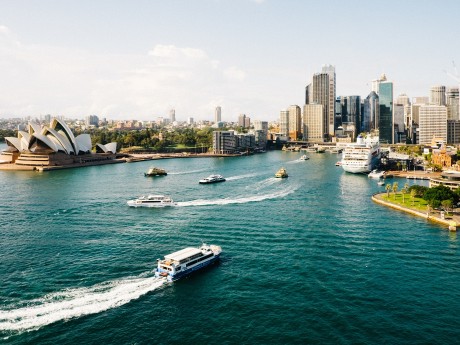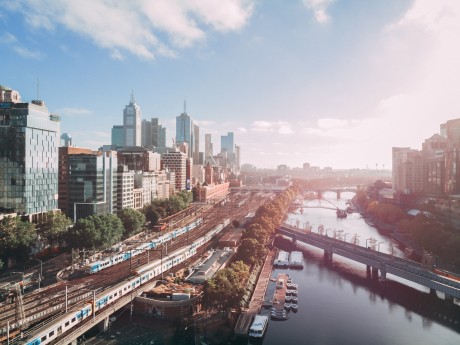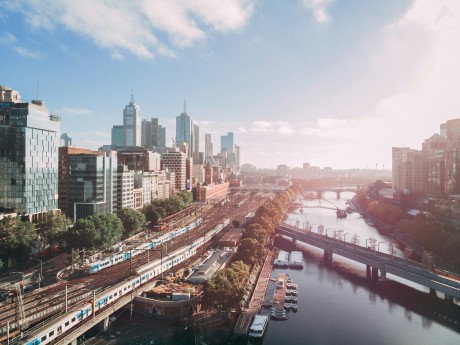Australia: Sydney & Melbourne
Embark on an Australian odyssey, exploring Sydney and Melbourne. Discover Sydney’s renowned Opera House and the magnificent Harbour Bridge while being surrounded by the city's dynamic energy. Visit Bondi Beach to soak up the sun, surf the waves or simply enjoy the view. Next, head to the vibrant city of Melbourne. Wander through the iconic laneways adorned with street art, explore the bustling Queen Victoria Market, or catch a performance at one of the city's renowned theatres.
Read more
Embark on an Australian odyssey, exploring Sydney and Melbourne. Discover Sydney’s renowned Opera House and the magnificent Harbour Bridge while being surrounded by the city's dynamic energy. Visit Bondi Beach to soak up the sun, surf the waves or simply enjoy the view. Next, head to the vibrant city of Melbourne. Wander through the iconic laneways adorned with street art, explore the bustling Queen Victoria Market, or catch a performance at one of the city's renowned theatres. For a taste of nature within the city, a stroll along the picturesque Yarra River or visit to the Royal Botanic Gardens. This adventure offers an unrivalled fusion of urban allure, coastal charm, and the wonders of nature creating an unforgettable Australian adventure filled with memories to last a lifetime! Waterviews strives to offer accommodation options within walking distance of water and/or in an area of touristic interest. Our prices include taxes (but excludes local tourist taxes). Customize your trip to your personal preferences with optional activities (hit the “Add Activities’’) or change hotels, etc. Contact us for customization at no extra cost at: Service@waterviewstravel.com
Destinations
- Sydney
- Melbourne
Itinerary
Sydney

Australia’s largest and arguably most popular city immediately conjures up images of the iconic Harbour Bridge and Opera House, yet Sydney has much more to offer. From the green parks and excellent beaches and the nearby Blue Mountains, to its excellent and creative gastronomic scene and interesting cultural attractions, Sydney has something for everyone. Spend a day exploring the history, attractions and culture of the city before exploring some of Australia’s finest nature.
Read more
Australia’s largest and arguably most popular city immediately conjures up images of the iconic Harbour Bridge and Opera House, yet Sydney has much more to offer. From the green parks and excellent beaches and the nearby Blue Mountains, to its excellent and creative gastronomic scene and interesting cultural attractions, Sydney has something for everyone. Spend a day exploring the history, attractions and culture of the city before exploring some of Australia’s finest nature.
Additional Information
History
Sydney is the oldest European settlement in Australia, having been founded as a British penal colony on 26 January 1788 by Arthur Phillip. This day is now celebrated as Australia Day to mark the establishment of a new nation, although also regarded by many as Invasion Day that marked the beginning of the British appropriation of Aboriginal land. The settlement was named "Sydney" after Thomas Townshend, 1st Viscount Sydney, who was the British Home Secretary at that time.
People
Sydney is one of the most cosmopolitan cities on the planet, with one third of its population born overseas. European settlement rapidly displaced the Aboriginal people of the Sydney area with colonists largely coming from England, Ireland and Scotland. The Australian goldrush attracted more immigrants, including a significant number of Chinese, with about one in six Australians with convict descent also having some Chinese ancestry. In the early 20th century, Sydney continued to attract immigrants - mostly from the UK and Ireland, with the White Australia Policy preventing non-European peoples (and even Southern Europeans) from settling. Australia's immigration patterns, and consequently, that of Sydney, changed significantly after World War II, when migrants began to arrive from countries as diverse as Italy, Greece, Germany, the Netherlands, China, New Zealand, India, the Philippines, Poland, Lebanon, Iraq, Vietnam, Thailand, South Africa and the Pacific Islands. Sydney's culture, food and general outlook well reflect these contributions to the majority Anglo-Celtic institutions and social establishment.
Sydney is recognised worldwide for its vibrant LGBT community. Every year, the Sydney Gay and Lesbian Mardi Gras is celebrated on the first weekend in March, drawing people from all over Australia and the world for the celebrations.
Sydney was the centre of the world's attention in September 2000 when the city hosted the Summer Olympics - announced by the IOC Chairman at the closing ceremony to be "the best games ever". The Olympics saw a major building and renovation program take hold of Sydney, positioning it as one of the great world cities of the 21st century.
Climate
|date=July 2017 }} Sydney enjoys over 300 sunny days each year, and it's a year-round destination. Avoid the hottest days for energetic outside activities, and avoid the coolest if you're planning a beach holiday. Summer (December to February) is the best time to enjoy Sydney's beachside outdoor lifestyle. Temperatures usually reach around 26°C (about 79°F) but it can be very hot, particularly further inland and to the west, with temperatures climbing to over 40°C (104°F) for a few days each summer. Summer days can be humid, and sometimes have searing dry winds, but hot days frequently end with a "southerly buster", a cold front sweeping up from the south, bringing a clearly noticeable drop in temperature, as well as rain and thunder. Within hours, the storm can pass and the evening continues cooler. Hot, windy days can create a risk of bushfire, and on days of severe risk national parks and walking trails may be closed. Occasionally low pressure systems drift down from the tropics, giving periods of more unstable weather. You won't need to pack much more than T-shirts to visit Sydney in summer, but remember your hat and sunglasses. Autumn (March to May) is still warm with mild nights. There can be good days for the beach in March, but you can't count on it. It is a good time for visiting attractions, going to the zoo, catching ferries around the harbour without the summer crowds. You may need a warm top for the evenings, especially for May. Winter (June to August) is cool, not cold. Average July maximum temperatures are 17°C, and daytime temperatures rarely drop below 14°C, but night-time temperatures can fall to below 10°C. Most rain falls as a result of a few off-shore low pressure systems, which usually result in two or three rainy weeks during winter. The Bondi Icebergs will be in the ocean doing their morning laps, but most of Sydney will be well away from the beach. It does not snow in Sydney, and unless you intend spending long periods outside, you can usually get by with just a warm top. Sydney is a year-round city, and only the outdoor water-parks close for the winter. If the beach isn't your scene, and you don't like the heat, winter may be your time to visit. Spring (September to November). Spring days are great for exploring Sydney's attractions, bushwalking, cycling, and the outdoors. Beaches are generally patrolled from the end of October, and Sydneysiders start flocking to the beaches in November.
Sydney's Western Suburbs, which lie away from the coast, tend to be hotter during the day, colder during the night and not receiving as much rain. They miss the afternoon sea breezes and the night-time warming effect of the ocean.
Most public buildings like shopping centres are climate controlled inside. Sydney has a fascination with year-round alfresco dining, where you can find yourself dining mid-winter outdoors with a heater a few tables away. Around 90% of public transport has heating and cooling. For the other 10% climate control consists of an open window. Carry water on a hot day.
Sydney climate and weather information is available online at the Australian Bureau of Meteorology.
Architecture
Sydney’s skyline is large and widely recognisable. Sydney also possesses a wide diversity of modern and old architectural styles. They range from the simple Francis Greenway's Georgian buildings to Jorn Utzon’s Expressionist Sydney Opera House. Sydney also has many Victorian buildings, such as the Sydney Town Hall and the Queen Victoria Building. The most architecturally significant structures include the Sydney Opera House and the Sydney Harbour Bridge. Skyscrapers in Sydney are also large and modern. The tallest building is the 300-m-tall Sydney Tower, seen rising clearly above the rest of the Sydney skyline.
There are also pockets of architecturally significant housing dotted around Sydney's suburbs. The inner-eastern suburb of Paddington is known for its terrace houses, while several inner-west suburbs contain streets lined with so-called federation houses (built around the time of Australian federation in 1901). A well preserved example of federation houses in Sydney is in the Inner West suburb of Burwood. Appian Way is a circular street built around a lawn tennis courts complete with pavilion house. The large houses are all architecturally unique and built on large expanses of land featuring old trees and lovely gardens. Further away on the lower North Shore, Castlecrag is a unique suburb, being planned by the architect Walter Burley Griffin in the 1930s.
Itineraries
Walking tour of Sydney - mainly around Central Sydney. Please see separate listing for detailed information. One week in Sydney - some ideas on how to spend a week in and around Sydney, exploring different areas
© Sourced from Wikivoyage
Melbourne

Melbourne is undoubtedly Australia’s cultural hub, a modern and cosmopolitan city offering something for everyone. Consistently named as one of the most liveable cities in the world, Melbourne’s multicultural charm shows in its lively streets filled with culinary delights, dazzling street art and art galleries and museums. The coastal city is home to a vast area of green parks and gardens, and visitors can take a stroll by the riverside to admire its impressive architecture and unique feel.
Read more
Melbourne is undoubtedly Australia’s cultural hub, a modern and cosmopolitan city offering something for everyone. Consistently named as one of the most liveable cities in the world, Melbourne’s multicultural charm shows in its lively streets filled with culinary delights, dazzling street art and art galleries and museums. The coastal city is home to a vast area of green parks and gardens, and visitors can take a stroll by the riverside to admire its impressive architecture and unique feel.
Additional Information
History
The British settlement of Melbourne commenced in 1835 when settlers from Tasmania "purchased" land on Port Phillip Bay and the Yarra River from the local Aboriginal people. The streets of central Melbourne were carefully laid out in 1837, with some streets 30 metres wide. The settlement was named "Melbourne" after William Lamb, 2nd Viscount Melbourne, the British Prime Minister at that time. The first British lieutenant-governor, Charles La Trobe, arrived in 1839 – his Cottage still stands and can be visited in the Kings Domain.
1851 was a landmark for Melbourne — the colony of Victoria was separated from New South Wales and very soon after, gold was discovered in Victoria, sparking a huge gold rush. The gold rush history can be seen at the Gold Treasury Museum, housed in the Treasury Building built in 1858. Gold was the catalyst for several decades of prosperity lasting through to the late 1880s and examples of the ornate Victorian-era structures built during this time still stand. Throughout the gold and building booms, Melbourne managed to retain its many spacious parks and gardens that remain to this day.
In 1888, the boom collapsed and Victoria suffered through the depression of the 1890s.
In 1901, the British colonies of Australia federated and Melbourne became the temporary capital of Australia, with the Federal Parliament meeting in the Parliament House of Victoria until 1927 when the new Federal capital of Canberra was founded. After World War II, Melbourne grew rapidly, with its mainly Anglo-Celtic population boosted by immigration from Europe, particularly from Greece and Italy. Today Melbourne has the biggest Greek population (over 800,000) of any city outside Greece and the biggest Italian population (over 230,000) of any city outside Italy. The significant pre-war Jewish population was also boosted after the war. From the mid-1970s, many immigrants came from Southeast Asia, particularly Vietnam and Cambodia. Melbourne has had a Chinese population since the gold rush of the 1850s. Chinatown has existed from that time but the population of Chinese and other East Asians has also been boosted by immigration.
New highrise buildings replaced many of Melbourne’s interesting old structures in the construction boom of the 1970s and 80s. Melbournians belatedly recognised the loss of their architectural heritage and steps were taken to protect what was left. Construction of the huge Crown Casino (briefly the largest casino in the world) in the 1990s introduced glitz and gambling to the city centre. Melbourne’s development continues in the 2000s with the opening of the Melbourne Museum, Federation Square and the Docklands precinct.
Culture
Melbourne is the cultural capital of Australia, with its many art galleries, film festivals, orchestras, choral and opera productions, vibrant live music scene, and a strong food, wine and coffee culture. People in Melbourne tend to dress up more than the northern states - partly due to the colder climate. Many bars and clubs have strict dress regulations, such as requiring collars and dress shoes for men.
Particular cultural events to note include the Melbourne International Film Festival in August, the International Art Festival in October, and the Melbourne Comedy Festival in April. There are also many concerts and exhibitions throughout the year. In addition to the Melbourne Museum, there are special museums dedicated to subjects such as science, immigration, Chinese history, Jewish history, sport, racing, film and moving image, railways, police, fire brigades and banking.
Sport
Melbournians are sports enthusiasts and particularly passionate about Australian rules football, a sport invented in Melbourne. In fact the Australian Football League (AFL) is not so much a sport as a religion in Melbourne, with 9 of the 10 Victorian teams being based in Melbourne. As a guide, the entire national competition only has 18 teams, meaning half the league is based in Melbourne alone. The AFL culminates in the AFL Grand Final in the spring, which is played every year at the Melbourne Cricket Ground. Horse racing is another passion, and the majority of the state has a public holiday on the first Tuesday of November for the racing of the Melbourne Cup, one of the world’s famous horse races. Cricket is the big summer sport and the Melbourne Cricket Ground (the 'MCG') is one of the world's leading grounds. The National Sports Museum (NSM) (including the Racing Museum) Australia’s only truly dedicated multi-sports museum is also located at the MCG.
Each January, Melbourne hosts tennis' Australian Open, one of the world’s four Grand Slam championships. In March, Melbourne hosts the first race of the Formula One season, the Formula One Grand Prix. The race is held in Albert Park in South Melbourne. Two professional Association Football teams are based in Melbourne, Melbourne Victory and Melbourne City FC; the two teams now share the new Melbourne Rectangular Stadium, commercially known as AAMI Park also playing at Etihad Stadium. The city also boasts one professional team in each rugby code, with both also playing at AAMI Park. The Melbourne Storm play rugby league in the National Rugby League, with teams throughout Australia plus one in New Zealand. The Melbourne Rebels play rugby union in Super Rugby, which features four other Australian sides and five each in New Zealand and South Africa. Melbourne is the unquestioned sporting capital of Australia with the largest arenas and two of the major sporting administrations basing their operation in Melbourne: Cricket Australia is a stone's throw from the MCG, and the AFL games are played at both the MCG and Etihad Stadium.
Climate
The city's climate has a notoriety for its changeability, often referred to as "four seasons in a day". Its climate can be described generally as temperate, with warm summers and cool winters. During the summer of December to February, temperatures hover around 26–30°C (79–86°F), but it is not out of the ordinary for the city to swelter through heatwaves of over 40°C (104°F). Humidity is rarely an issue, with mildly comfortable nights down to about 16°C (61°F). With approximately 600 mm of rainfall annually, Melbourne gets only half as much rain as Sydney. October is typically the wettest month.
Winter (June–August) is usually cool with a mix of clear, sunny weather and cold & damp conditions. Temperatures in winter can range from chilly overnight lows as low as 2 °C (36 °F) to daytime highs as high as 19 °C (66 °F) at times. Light snow has been recorded in and around Melbourne during the winter months only a couple of times over the last century, although the hills east of the city usually see a snow shower or two every winter. You should consider visiting Melbourne in the autumn and spring — temperatures during these periods are usually very pleasant, without being unbearably warm with daytime highs usually in the 20s °C (70s °F).
With such wild and unpredictable weather, it can be difficult deciding what to wear when planning a day out in Melbourne. A common tip is to wear layers of clothing, that can be removed or worn as the day goes on.
© Sourced from Wikivoyage





